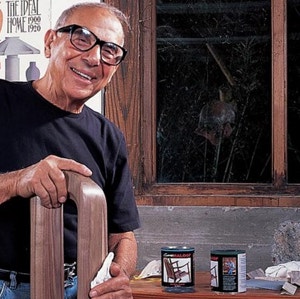Mixing an Oil and Wax Finish?
I would like to make a finish for wood projects out of beeswax and linseed oil. Could you tell me how to go about mixing it and what proportions to use? I am always seeing articles where it has been used but nothing about the mixture or the method. - Mike Brown
Tim Inman: Oil/wax finishes are quite popular and easy to make up. They are not "durable" as far as protective qualities go, but they are very attractive in addition to being quick and easy. Nothing has a better "hand" or feel than a wax/oil finish, with the exception of a fine, true French polish — which also uses wax and oil. Great for ornaments and things that aren't that "utilitarian."
The "secret formula" is yours. Beeswax (and many other waxes) melts in solvents like mineral spirits, VM&P naptha, turpentine, etc. Don't use things like lacquer thinner or acetone. Coincidentally, these same solvents that melt waxes also blend with drying oil finishes like linseed, tung, etc. So, my suggestion is that you first melt a lump of beeswax in some thinner or naptha — which dries faster. Once the wax has softened into a jelly-like mass, then cut or mix that into your oil of choice. How much? You'll need to experiment a little until you get the blend you like best. There isn't a technical limit that I know of. If you want a more buffable mix, I'd start out with more wax and less oil. If you want the deep penetration of the oil with a little buffing wax on top, then use more oil and less wax. The famous Sam Maloof finish is a varnish/oil blend.
So, there you go — no answer but more confusion. Everybody has their own "secret" version of this long-time favorite blend. It is now your turn to make up yours. They all work.
Chris Marshall: Expert woodworker Ian Kirby uses a ratio of five parts pure turpentine to one part pure granulated bleached beeswax. He combines the two in a container and lets it dissolve overnight. It produces a compound with the consistency "of a block of butter just before it loses its shape to melting." He often uses it as a final polish over shellac for its "smooth as silk" feel when buffed.
I once tried to warm and melt beeswax into mineral oil. I should have asked Ian or Tim first, on two accounts: I should have used a drying oil instead of a non-drying oil and started by melting the wax into a solvent, then cutting that mixture into the oil. What I ended up with was something sort of spreadable with a cloth and capable of being buffed to a degree, but it didn't stay soft for long before re-solidifying into a hard lump when it cooled. I won't do that again. We live and learn.
Keep the inspiration coming!
Subscribe to our newsletter for more woodworking tips and tricks




